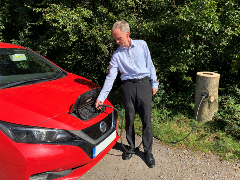Love them or loath them, electric cars are what we’ll all be driving in just a few years’ time and while petrol-heads around the world will lament its passing, the Internal Combustion Engine (ICE) will be consigned to the automotive history books forever.
 Here the aptly named Dunstan Power, director of charging station manufacturer Versinetic, and his team, give their predictions on what developments we can expect during the coming year.
Here the aptly named Dunstan Power, director of charging station manufacturer Versinetic, and his team, give their predictions on what developments we can expect during the coming year.
Despite coronavirus, the plug-in vehicle market in Europe grew by well over 100% in 2020 and the same is likely to happen in 2021.
Battery Electric Vehicles (BEVs) sales will grow by more than 100% and surpass the current growth of plug-in hybrids (PHEVs). In 2019, the UK sold 38,000 BEVs and is on track to sell between 98,000 and 101,000 BEVs by the end of 2020.
Along with the rest of the industry, Versinetic is predicting that in 2021 there will be over 200,000 BEVs sold; approximately 70,000-80,000 PHEVs, and over 125,000 Hybrid Electric Vehicles (HEVs) in the UK alone.
The HEV market will continue to grow, but more slowly, meaning that pure BEVs will outsell non-plug in hybrids over the whole year. Then, assuming there is limited economic damage after the end of the UK's EU transition period, BEVs will continue to outsell HEVs for at least the first six months of 2021.
The Osborne Effect
The Osborne Effect is where a company suffers a financial crisis due to its customers postponing or cancelling orders whilst waiting for the newest version of its technology.
In this case, it means that at least one major car manufacturer will ask for a government bailout; large-scale redundancies of ICE vehicle workforce and in particularly ICE R&D teams will effectively spell the end of the ICE era, since no new engines will make it onto the market.
Emissions will at last start to fall, but - paradoxically - by less than they should because people are keeping older cars on the road. Another influential factor will be the growing number of second-hand electric vehicles coming onto the market as earlier adopters upgrade to their second or third EV.
As a consequence, those key drivers for greater uptake over EVs for next year – together with tax incentives for fleets – will have a knock-on effect in pushing charging infrastructure forward.
Increased price pressure for low cost chargers
With anticipated growth in the number of EVs on our roads, we’re likely to experience strong price pressure for low cost chargers during 2021. Despite reliability concerns around quality of some chargers on the market, sales of EV chargers will grow, but this will be coupled with a downward pressure on price.
In the UK, much of the low-cost charger market is driven by installers, particularly with new government regulations coming in around the requirement for new build homes to be equipped with electric vehicle chargers. Ultimately, both public and domestic chargers will get cheaper due to economies of scale and competition.
Payment and scheduling system improvements for EV charging
Debit card payments will become the norm, rather than bespoke app or web-based systems. Innovative apps will become available to better manage public charger scheduling. The challenge of making public chargers pay for themselves, however, will remain, primarily because domestic electricity is cheap and utilisation is currently low (approximately 10%) making payback periods long.
Nevertheless, since there is a net economic benefit in driving EVs it should be possible to use this to finance the charging infrastructure whilst supporting the market.
Retreat from government subsidies
Government policy has had a massive influence on EV sales and chargers. Across Europe, although government policies differ country by country, they have helped to strongly influence take up of charging infrastructure.
In a business as usual scenario, subsidies will fall once the EV market has enough momentum, but on the other hand, the disruptive effect of EVs threatens car manufacturers and the greater urgency over decarbonisation means that governments will have to provide larger subsidies to car manufacturers.
Next year, we will begin to see a move away from everything being driven by government incentives. The public need to be weaned off subsidies and buy EVs just as they would make any major purchase. As the volume of EVs increases, the cost to manufacture them should decrease, making them more affordable. So, from 2021 onwards, we predict governments will start to scale down EV incentives.
ICE vehicles will start to become unacceptable
The EV revolution has a cultural side too. Because exhaust pollution is especially noticeable in high-traffic areas, we anticipate that ICE vehicles will start to become less socially acceptable, especially in the wake of the cleaner air so many experienced during the COVID-19 lockdown.
Photo: Dunstan Power with one of Versinetic’s more quirky charging stations.